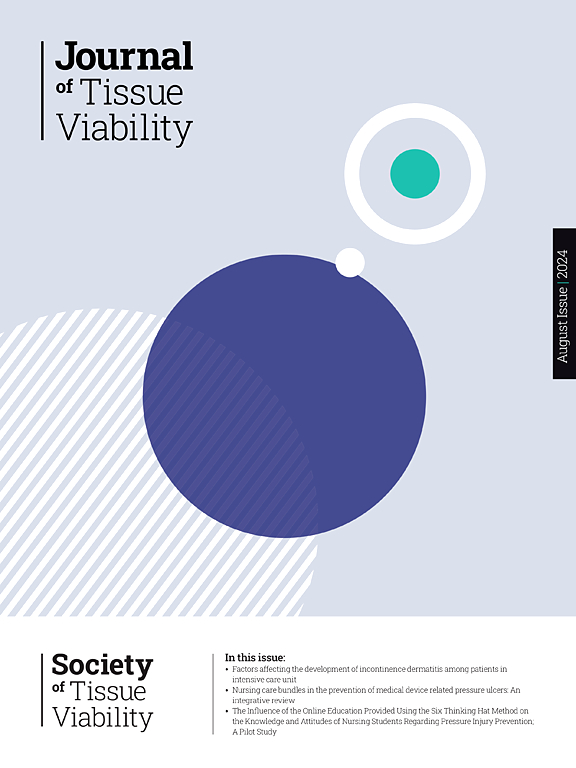糖尿病足溃疡患者:关于患者知识、经验和所遇障碍的定性研究。
IF 2.4
3区 医学
Q2 DERMATOLOGY
引用次数: 0
摘要
背景:糖尿病患者可能会出现糖尿病足溃疡,这是糖尿病的长期并发症,可因高血糖失控而发生。患者和医护人员的疏忽会加速足部溃疡的发展:目的:了解患者对糖尿病足溃疡的认识、经验和相关障碍:这是一项基于内容分析的定性描述性研究。研究对象为土耳其一家公立医院伤口护理门诊的住院患者。数据通过详细的电话访谈收集。11 名患者的数据达到饱和。数据分析使用了 MAXQDA 20 软件。COREQ 检查表用于指导研究报告:结果:确定了 5 个主题和 14 个次主题。主题:病因;影响;治疗过程;障碍;建议。根据主题 1,忽视、压力、创伤和慢性疾病可导致糖尿病足伤口。根据主题 2,在参与者身上观察到了生理和心理影响。根据主题 3,参与者的治疗管理和治疗依从性影响了糖尿病足的恢复过程。在主题 4 中,观察到患有糖尿病足伤口的参与者在进行日常生活活动和体力活动时遇到困难。在主题 5 中,参与者对糖尿病足溃疡患者的建议包括调节血糖、保持健康的生活方式、提供足部保护和护理以及提供专业的健康支持:结论:糖尿病足溃疡的形成是由于患者和医生的疏忽。结论:糖尿病足溃疡的发生是由于患者和医生的疏忽,患者也害怕截肢。通过提供培训,提高人们对血糖控制和糖尿病足溃疡的认识,足部溃疡是可以预防的。患者对糖尿病足溃疡的早期自我识别以及医护人员的早期干预都非常重要。本文章由计算机程序翻译,如有差异,请以英文原文为准。
Patients with diabetic foot ulcers: A qualitative study of patient knowledge, experience, and encountered obstacles
Background
Patients with diabetes may experience diabetic foot ulcers, which are long-term complications of the disease and can occur due to uncontrolled hyperglycemia. Foot ulcer development is accelerated due to the negligence of the patient and the healthcare professional.
Objective
To determine patient knowledge, experiences, and barriers associated with diabetic foot ulcers.
Methods
This was a qualitative descriptive study based on content analysis. The study was conducted with patients admitted to a wound care outpatient clinic in a public hospital in Turkey. The data were collected through detailed telephone interviews. Data saturation was achieved for 11 patients. MAXQDA 20 software was used for the data analysis. The COREQ checklist was utilized to guide the reporting of the studies.
Results
Five themes and 14 subthemes were identified. Themes: etiology; impact; treatment process; barriers; recommendations. According to Theme 1, neglect, pressure, trauma and chronic diseases can lead to diabetic foot wounds. According to Theme 2, physical and psychological effects were observed in the participants. According to Theme 3, participants' treatment management and compliance with treatment affected the diabetic foot recovery process. In Theme 4, it was observed that participants with diabetic foot wounds had difficulties performing daily living activities and physical activities. In Theme 5, the participants’ recommendations for individuals with diabetic foot ulcers included regulating blood sugar, maintaining a healthy lifestyle, providing foot protection and care, and providing professional health support.
Conclusion
Diabetic foot ulcers developed due to the negligence of patients and physicians. Patients were also afraid of foot amputation. The development of foot ulcers is preventable through the provision of training to spread awareness regarding blood sugar control and diabetic foot ulcers. Early self-recognition of diabetic foot ulcers by patients, along with early intervention attempts by healthcare professionals, are important.
求助全文
通过发布文献求助,成功后即可免费获取论文全文。
去求助
来源期刊

Journal of tissue viability
DERMATOLOGY-NURSING
CiteScore
3.80
自引率
16.00%
发文量
110
审稿时长
>12 weeks
期刊介绍:
The Journal of Tissue Viability is the official publication of the Tissue Viability Society and is a quarterly journal concerned with all aspects of the occurrence and treatment of wounds, ulcers and pressure sores including patient care, pain, nutrition, wound healing, research, prevention, mobility, social problems and management.
The Journal particularly encourages papers covering skin and skin wounds but will consider articles that discuss injury in any tissue. Articles that stress the multi-professional nature of tissue viability are especially welcome. We seek to encourage new authors as well as well-established contributors to the field - one aim of the journal is to enable all participants in tissue viability to share information with colleagues.
 求助内容:
求助内容: 应助结果提醒方式:
应助结果提醒方式:


